Move language profile
| Founding time | 2019 |
| Move language origin | Originated from Facebook's Libra project and modified from the Rust language |
| Move language blockchain | Aptos, Sui |
| Move language features | Low development difficulty and high security |
Development advantages |
|
| Founding team | Rushi Manche, Cooper Scanlon |
Introduction to Movement
Movement is a modular framework based on the Move language, which is used to develop various Dapps and blockchains. It is committed to promoting the powerful security and performance of the Move language to the entire blockchain industry.
Through the Movement framework, non-Move language-based blockchains can obtain the advantages of the Move blockchain without having to write any Move language. Although the learning cost of Move is not high, this greatly reduces the development cost and achieves Move compatibility with Solidity and EVM.
It is worth noting that unlike the well-known Move language blockchains Aptos and Sui, which both use the Move language to create new L1 blockchains, Movement has focused on L2 and launched the first Ethereum L2 built with Move. , combining the ecological advantages of both.
How to understand Movement through three characteristics and its differences with other L1
Movement architecture
Movement's main architecture includes the M1 and M2 blockchains, and it develops the Movement SDK tool suite. Through these tools, Solidity and Move developers can easily start building the Movement ecosystem.
M1 - Movement’s decentralized sequencer
According to the official description , M1 is a lightweight Move L1 blockchain that uses its own validator to integrate multiple blockchains such as Move and EVM using the Move stack, and develops into a decentralized sequencer. The consensus mechanism adopts the snowman mechanism. Snowman is one of the important consensus protocols running on the Avalanche main chain C-chain. It is characterized by its ability to handle high throughput and transaction volume, and it can quickly complete consensus and provide transaction confirmation.
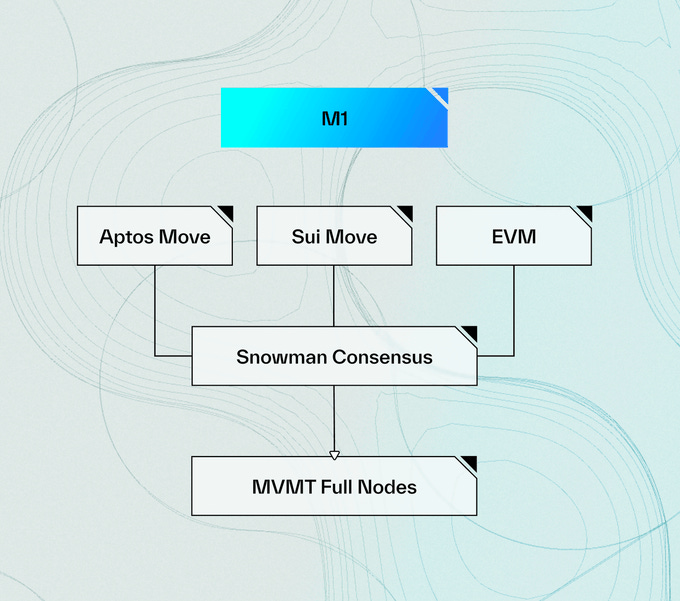
M1 will feed back all transaction fees to the staking verifiers. This mechanism will attract more people to join the ranks of verifiers. Adding more verification nodes will increase network security and staking income, and can promote the formation of a positive flywheel in the economy of the ecosystem. .
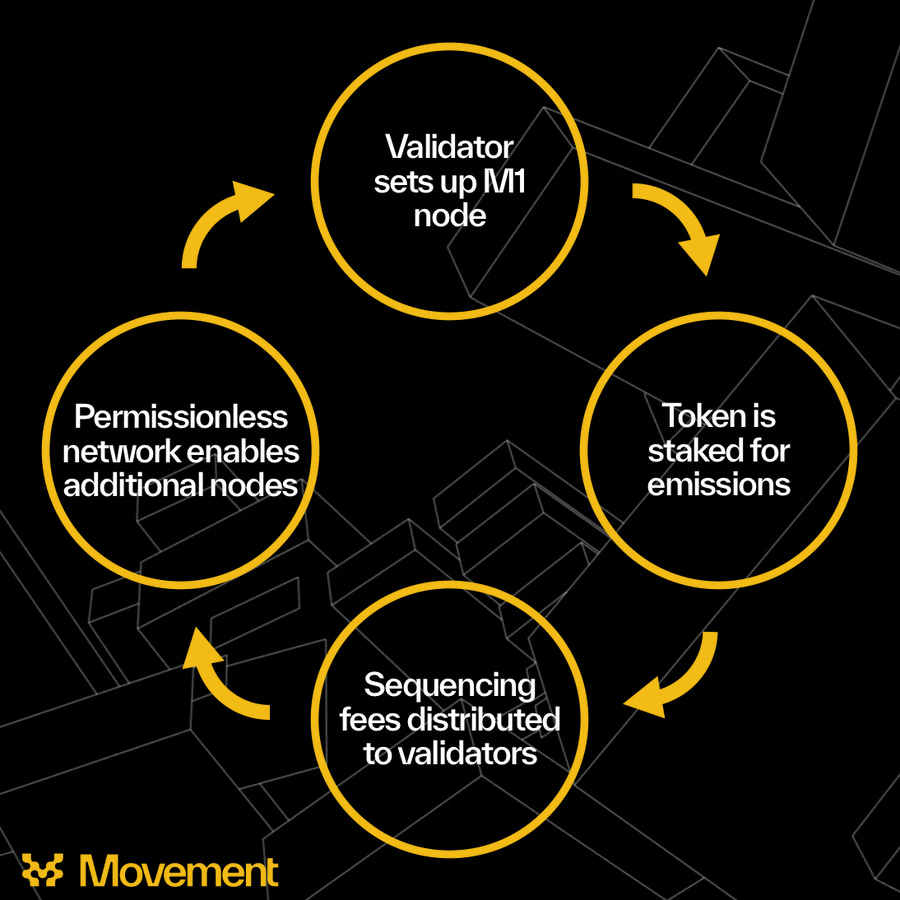
M2 - Movement L2 mainnet
M2 is the Ethereum L2 blockchain that integrates M1 and ZK-Rollups. M2 serves as the mainnet of Movement. The execution layer uses MoveVM to efficiently process EVM transactions, and integrates Celestia's data availability layer, using a modular architecture to accommodate flexibility.
One of the keys to the Move language's ability to process transactions at high speed is parallel transactions, which is evident on the Sui blockchain. Movement converts EVM bytecode into Move bytecode, allowing Movement M2 to use Move's parallelism. Processing enables high throughput on the EVM.
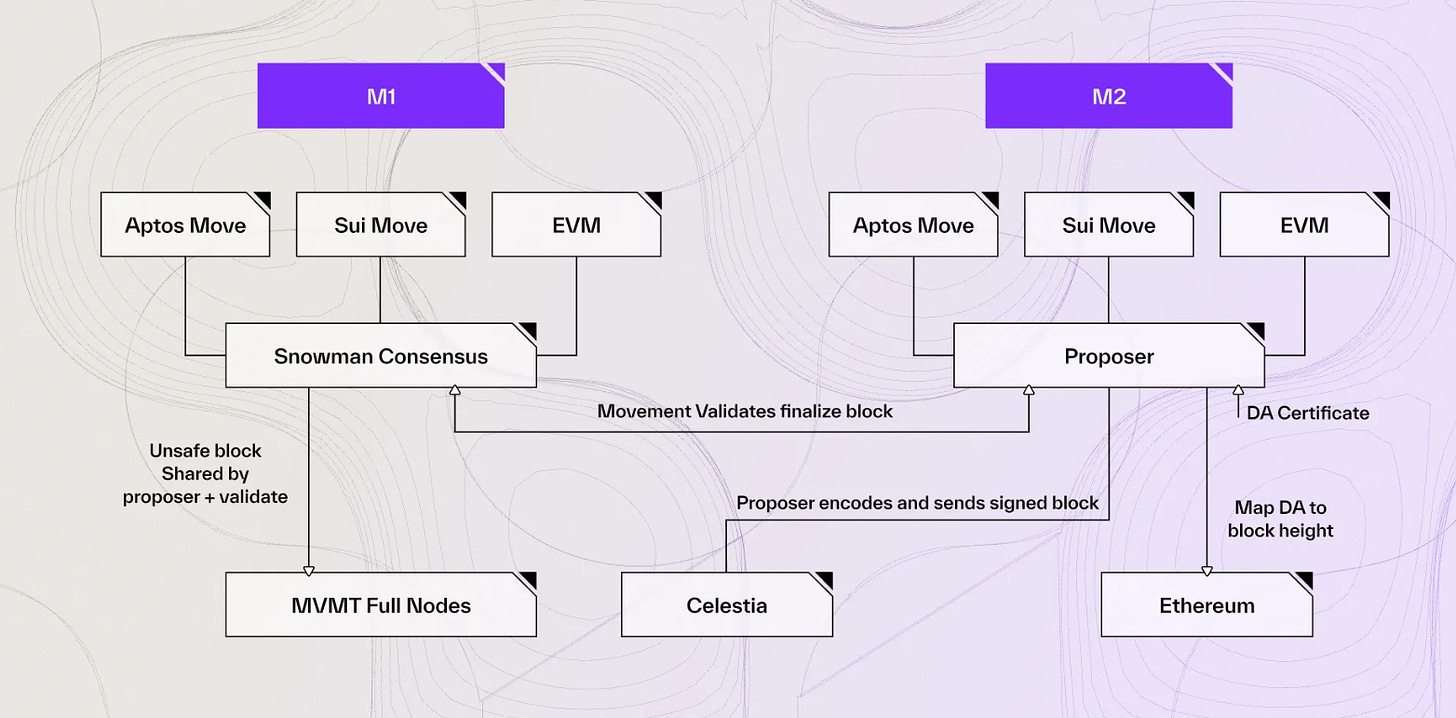
Based on this architecture, Dapps on M2 can support multiple blockchains while maintaining the high performance of the Move blockchain and the security of Ethereum, which indeed opens up more possibilities for blockchain applications.
Movement SDK: Powerful developer kit
Movement SDK is Movement's developer kit, which mainly contains three main components: MoveVM, Fractal, and Adapters. Movement official also provides detailed deployment instructions , including Aptos, Sui, and EVM environments.
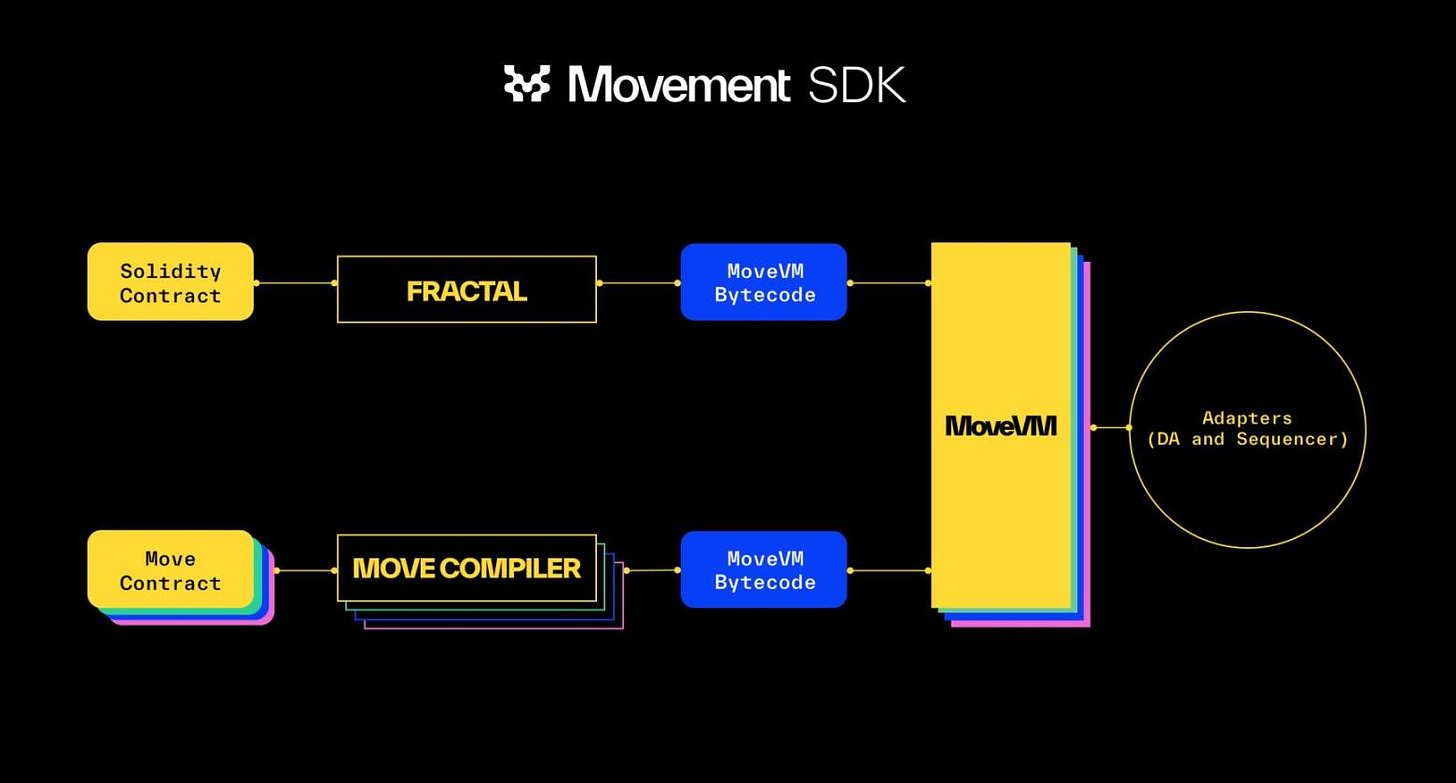
MoveVM
Movement's MoveVM is the key to M2's high performance. It has the following characteristics
Realize real asset transfer: Unlike EVM's common ledger record, this is also a feature of the Move language family, which improves the authenticity and security of transactions.
Use language structure to ensure data accuracy: The powerful features of the Move language system are that security is not determined by program logic, but by grammatical rules.
Bytecode verification: This verification ensures that all smart contract rules comply with regulations, greatly reducing the risk of malicious attacks on the contract.
MoveVM uses parallel technology to efficiently sort transactions in the blockchain, reducing the traffic jam problem caused by a large number of transactions. Combined with the modular blockchain, in addition to retaining the advantages of independent optimization and upgrades, it also expands services to other areas, allowing MoveVM to Has strong interoperability.
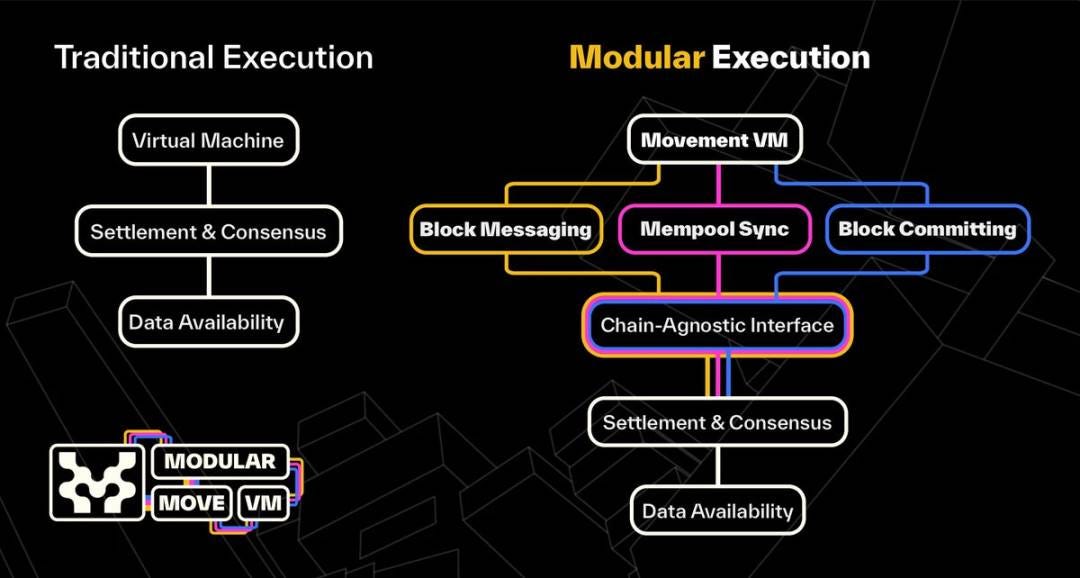
Fractal
Fractal can be interpreted as a Solidity-to-Move program compiler. Fractal allows smart contracts written by Solidity programs to be directly connected to MoveVM. This allows developers to develop on M2 without writing Dapps in the Move language. It can be said that Fractal is integrated The advantages of building blockchain using two programming languages: Solidity and Move.
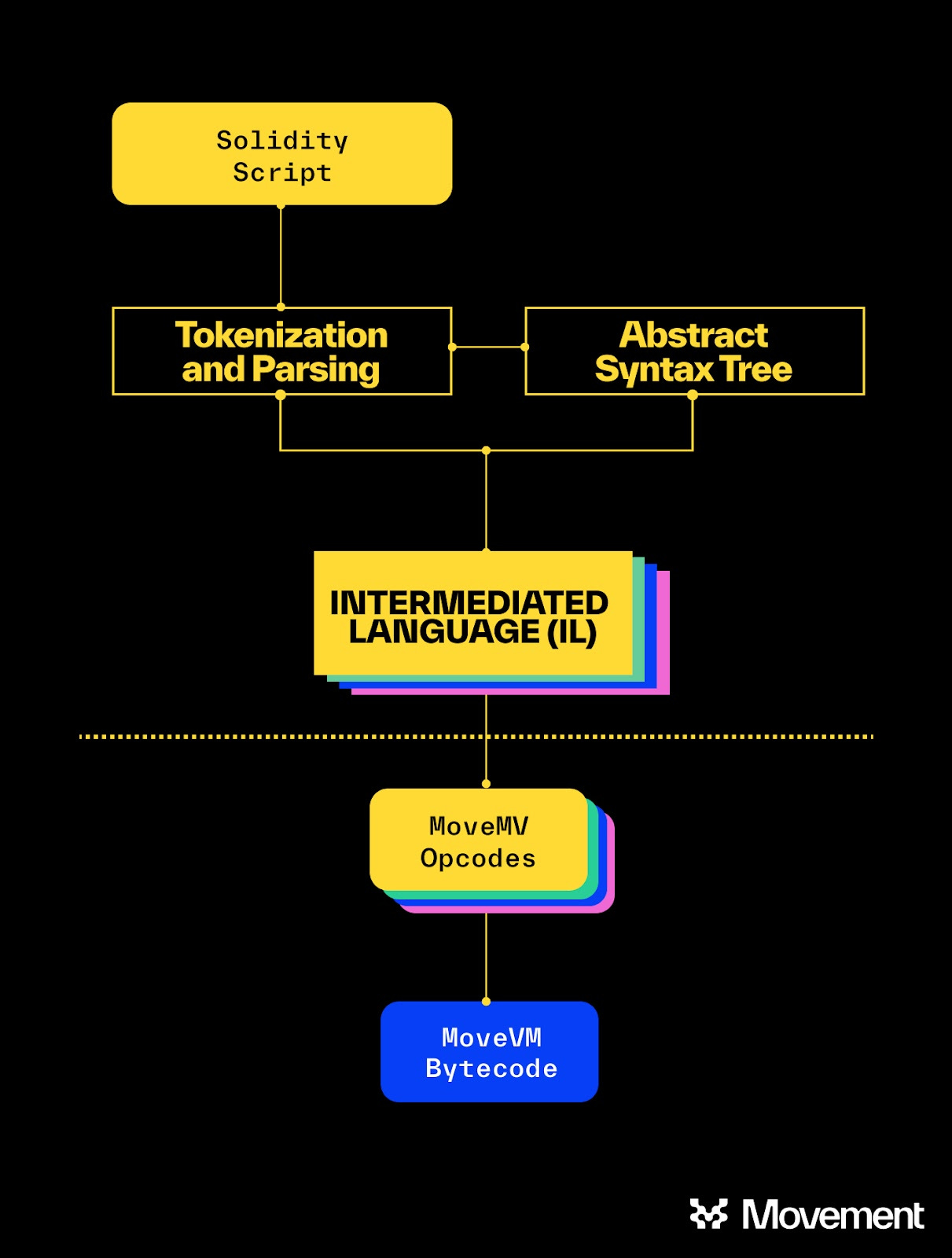
Adapters
Adapters are Movement's custom converters, mainly to integrate multiple data availability (DA) layers and decentralized sorters (M1) to ensure the accessibility of transaction data. Adapters allow Movement to support various DA layers, including Celestia , EigenDA, Avail, etc.
Movement team background
Founding Team Movement Labs
The Movement Labs team was founded in November 2022. The two founders of Movement Labs are Rushi Manche and Cooper Scanlon, both of whom studied at Vanderbilt University in the United States.
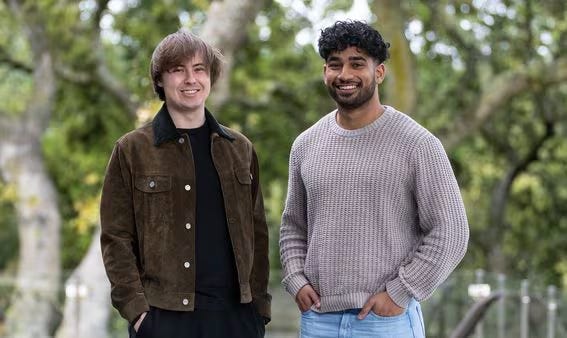
Rushi Manche mainly served as a front-end and full-end engineer in 2020, and founded the AI-driven exam preparation system ensemble to help high school students obtain some exam preparation resources. However, as early as 2019, he began to get in touch with the Ethereum Solidity and CosmWasm projects. Program development and became a Solidity program development engineer. In 2022, he joined Aptos and became a developer of the decentralized exchange Kairos Exchange and the cross-chain index fund Mira Finance. At the same time, he discovered the powerful potential of the Move language.
Cooper Scanlon has built SPAC DAO tools, audited and built the first revenue aggregator built in Move language. Cooper Scanlon revealed in the interview that he had a strong interest in the encryption market while in college and became a As a member of the blockchain club, he participated in the editing of ABMedia and project research. At the same time, he discovered the advantages of the Move language and fell in love with the Move language.
In addition, there are two engineering directors in the team. Franck Cassez has worked for ConsenSys, Andy Bell has served as Biconomy technical director and Ajuna technical director, and strategy director Brian Henhsi has worked for the Mysten Labs team of Sui Blockchain. It can be seen that the Movement team is in Has considerable experience in blockchain development.
Financing background
Pre-seed round: In September 2023, it received US$3.4 million in investment led by Varys Capital, dao5, Blizzard Fund, Borderless Capital and other institutions. It is worth noting that in this round, you can see the support of the Avalanche ecosystem for Movement, Movement M1 Also uses a lot of Avalanche blockchain technology.
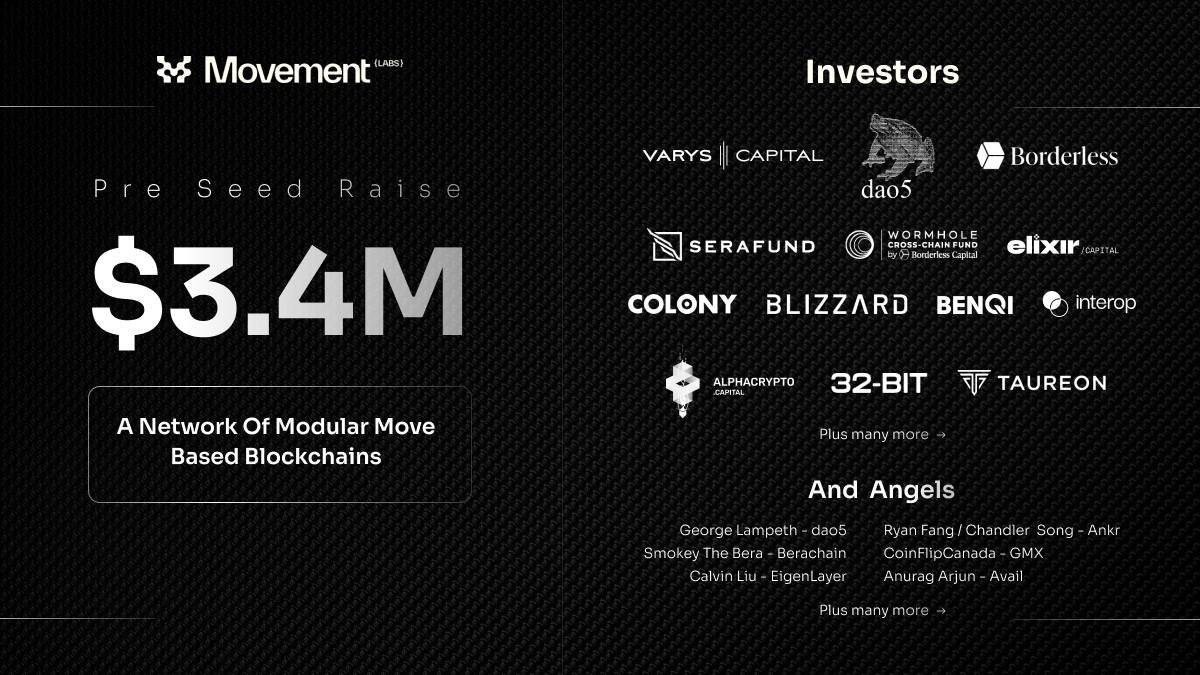
Series A: Received US$38 million in funding led by Polychain Capital in April 2024. Participating institutions include Hack VC, OKX Ventures, Placeholder, Archetype, Robot Ventures, Figment Capital, Nomad Capital, Bankless Ventures, dao 5 and Aptos Labs, etc. Multiple institutions participated in the investment, and this round of financing attracted a lot of market attention to Movement.
In May 2024, Binance Labs announced its investment in Movement. The specific amount was not disclosed, but Binance co-founder and head He Yi commented on Movement: “Movement’s technology and modular approach meet the need for integrated blockchain networks and liberate The potential to improve security and speed. At Binance Labs, we are always looking for innovators who are shaping the industry, and we look forward to seeing Movement’s continued growth.”
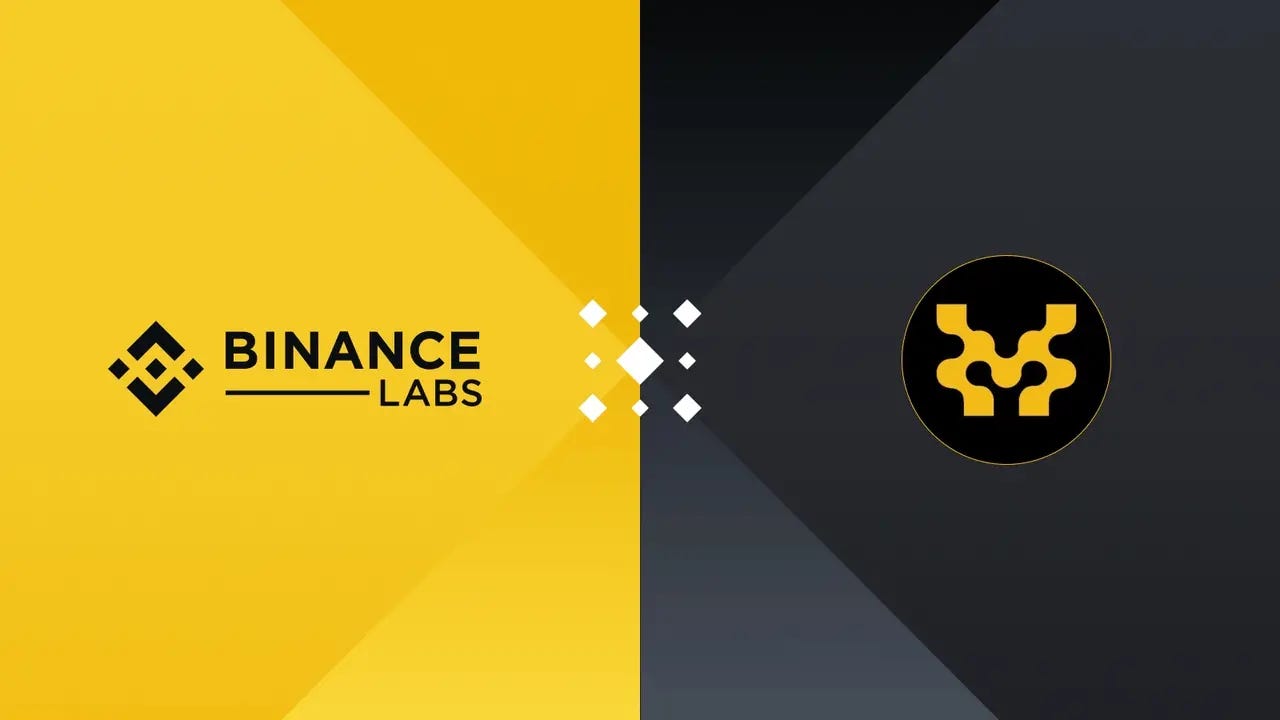
▌Research and discuss with the Biyan community. Welcome to join the daily Biyan Chinese exchange group !
▌Subscribe to the daily Coin Research e-newsletter (one article per week to quickly understand market conditions, on-chain data and potential project developments)
Movement latest news
Battle of Olympus Hackathon
Movement launched a hackathon event on June 13th, allowing developers from all over the world to use their creativity on Movement and receive bonuses to add more applications and ecology on Movement. The competition period is from July 17th to 9th On September 17th, it will last for 2 months, and the winning team will finally be announced in mid-September. Readers who are interested in Move language development can refer to the official link and form .
Launches Web3 smartphone Up Mobile in partnership with Up Network
Up Network is a blockchain abstraction layer, mainly used to connect mobile electronic devices and blockchain technology. It will cooperate with Movement to launch the Web3 smartphone Up Mobile. Up Mobile will support EVM and MoveVM in the future, and is compatible with Sui, Aptos, etc. In addition to verifying digital identity and protecting customer privacy through zero-knowledge proof and biometric identification systems, the Move language blockchain also incorporates AI's large language model into the mobile phone system to assist in arranging daily activities, itineraries, etc., and will also introduce Web3 intelligence Wallet, Dapp store, abstract account and Depin suite and other blockchain applications.
It is worth noting that, like the Solana mobile phone, many users expect to receive an airdrop when purchasing the Web3 smartphone Up Mobile. According to official sources, Up Mobile will confirm that there will be an airdrop of 1% of the total amount of Move and 10% of the Up Network itself. Airdrops are used as rewards, and there are already more than 40 ecological partners, successfully creating market expectations.
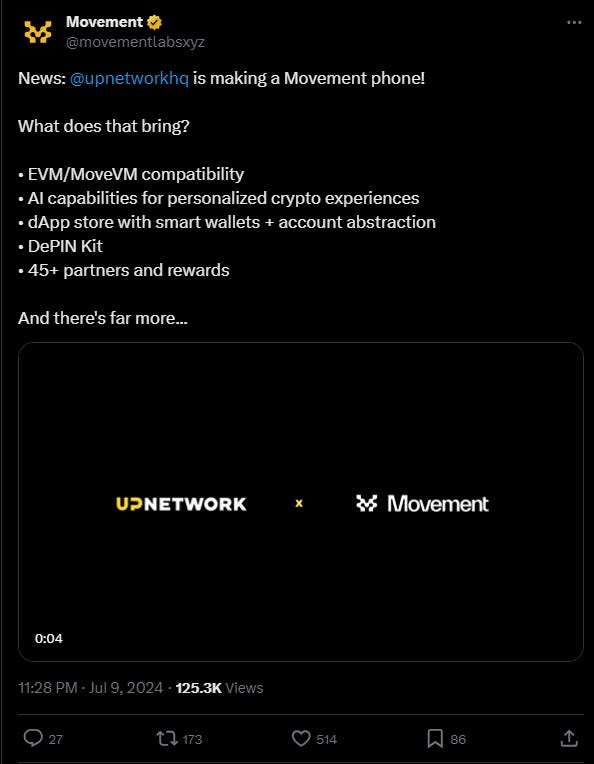
Movement Ecological Inventory and Testnet Popularity
At present, there are many protocols under construction on the test network on Movement M2, including some Defi protocols and DEX, such as StakeStone , Cedro , EchelonMarket , GoGoPool , Interest DEX , RazorDex , decentralized wallet application RazorDAO , infrastructure SeamMoney , SkipProtocol , Mintify , etc. Yi platform BRKT and other protocols can be said to be quite lively.
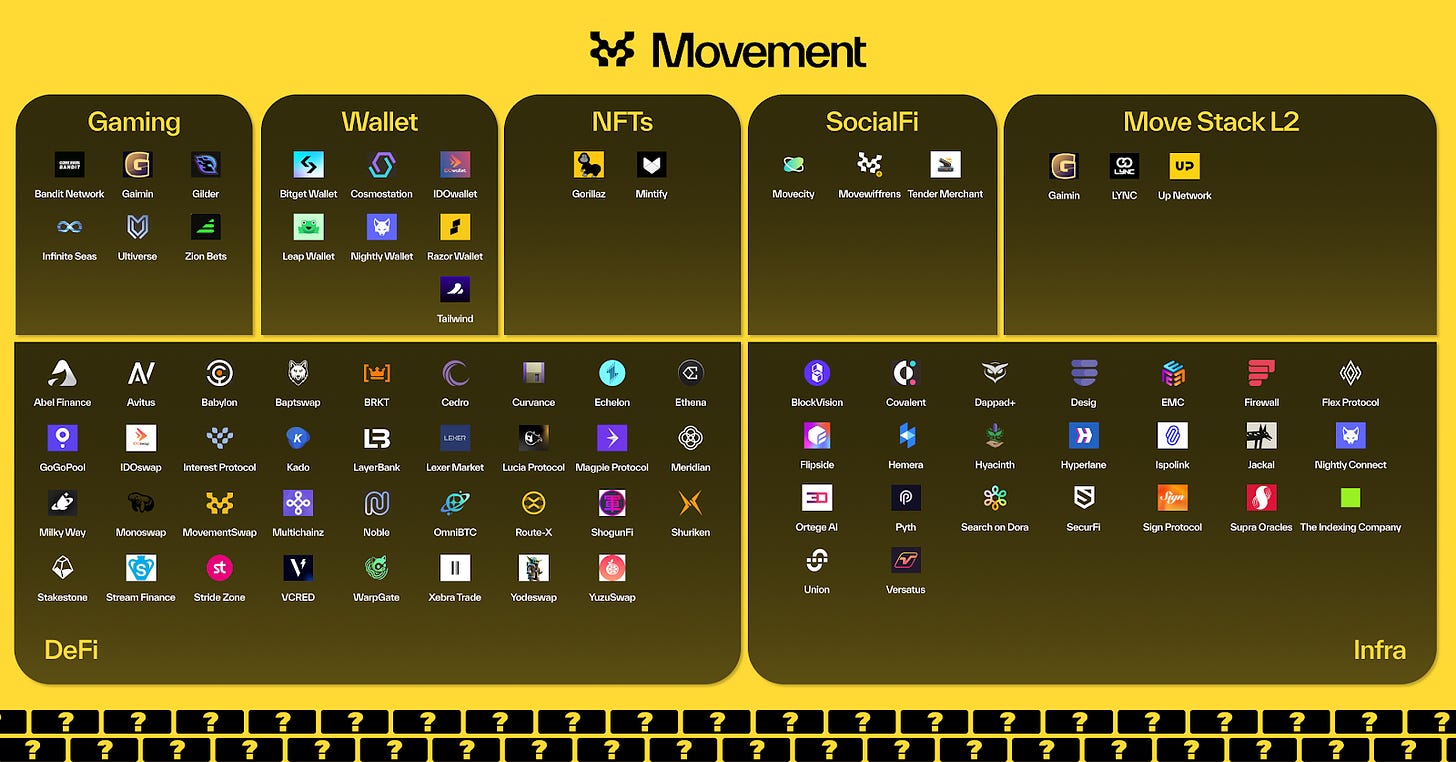
According to Kruys Collins' on-chain data analysis tweet , it can be seen that Movement's current test network has a large number of test interactions. Currently, M1 Devnet has completed more than 25 million transactions and has more than 1.5 million users. The average confirmation time of each transaction is 0.19 seconds, and the average single-day TPS is 11. Judging from these data, Movement is quite popular and has gathered a group of developers. However, as a Move integrated environment across multiple blockchains, higher TPS is needed in the future to convince market.
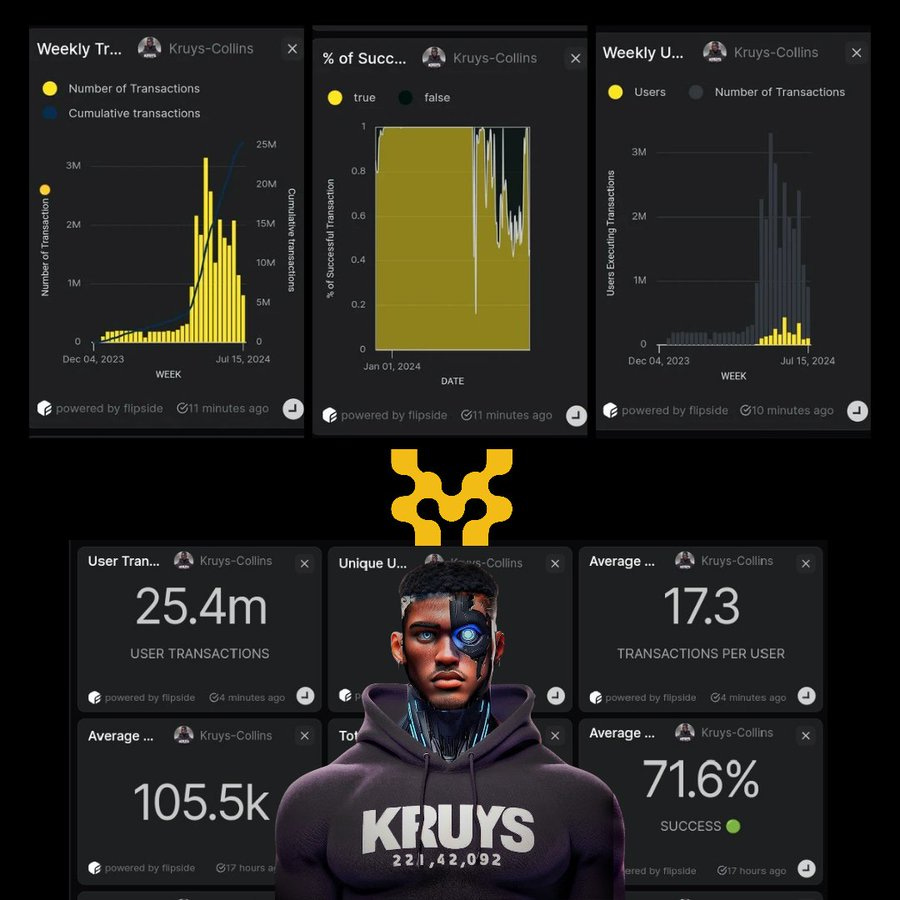
Conclusion
The Move language brought a brand-new concept to blockchain developers when it appeared in Aptos and Sui. In addition to the native architecture of the programming language that can maintain a high degree of security, and the common ledger model that is different from Ethereum Solidity, the Move language is more like It is a "real" transfer of blockchain assets. These characteristics give both Aptos and Sui the advantages of technology development and gain a certain degree of market attention.
The fragmentation of the blockchain ecosystem is still a problem. Due to different systems, it is difficult for Aptos and Sui of the Move language to communicate, let alone the integration of EVM. Although efforts are being made to abstract chain abstractions and cross-chain protocols, they still seem to be developing. Among them, the emergence of Movement has rekindled hope for blockchain integration. If Movement can bring the powerful system of Move language into the entire EVM blockchain ecosystem, it will greatly improve the security and performance of the blockchain. The author is also very optimistic about Move. Let us wait and see the development of the language family!
More selected articles in the Move series: Created by Pontem, the core team of Aptos ecosystem, Layer 2 connecting Aptos ecosystem and Ethereum - Lumio will create an interconnected Layer 2 ecosystem - Daily Coin Research
▌Research and discuss with the Biyan community. Welcome to join the daily Biyan Chinese exchange group !
▌Subscribe to the daily Coin Research e-newsletter (one article per week to quickly understand market conditions, on-chain data and potential project developments)
References
https://x.com/movementlabsxyz/status/1747746333086171183
https://docs.movementnetwork.xyz/








